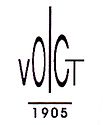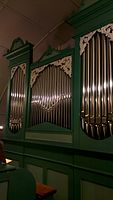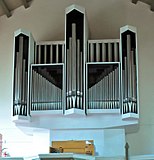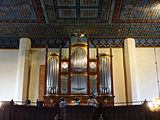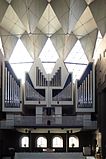Central German organ building A. Voigt
| Central German organ building A. Voigt
|
|
|---|---|
| legal form | GmbH |
| founding | 1905 |
| Seat | Bad Liebenwerda , Germany |
| management | Markus Voigt (Operations Manager) Matthias Voigt (Operations Manager) |
| Branch | Musical instrument making |
| Website | www.orgelbau.de |
The Mitteldeutsche Orgelbau A. Voigt is an organ building company based in Bad Liebenwerda .
history
After training with Rühlmann (Zörbig), Geissler (Eilenburg) and Schlag & Söhne (Schweidnitz), Arno Voigt (1876–1930) founded an organ construction company in 1905 from the estate of his uncle, the organ builder Christian Friedrich Raspe (1822–1892) in Liebenwerda. He managed the company until 1930. During this period, only organs with pneumatic cone chests were produced. There was an expansion of the workshops and an increase in the number of employees to up to 25 people at peak times. In 1914, the company was awarded a gold medal by the “General Industry and Trade Exhibition” in Liebenwerda for its excellent performance. However, the outbreak of the First World War almost brought about an interruption in work activities. In the post-war and inflationary period, some projects were won and carried out despite the difficult economic situation. Arno Voigt's son Arno Voigt jun. (1903–1986) learned during the war in the family organ business and began studying music at the conservatory in Dresden. The combination of organ building and church music has been a distinctive tradition since the beginning of the company up to the present day (fourth generation). With the beginning of the Second World War , the company almost came to a standstill.
The two sons, Dieter Voigt (* 1935) and Gisbert Voigt (* 1940), received piano and organ lessons as well as training in organ building. Dieter Voigt studied church music in Halle (Saale) from 1953 to 1958 and graduated with an A-exam . Dieter has been a master organ builder since 1970. Gisbert passed the master carpenter exam in 1961 and the master organ builder exam in 1966. The third generation took over the company from their father in 1961, which was run by both sons. From then on, they only produced organs with slider chests and mechanical soundtracks .
The company was able to withstand the increasing nationalization of companies during the GDR era. In 1978, the company received the title of “ Recognized Artisan ” for its achievements - at that time an unusual award for a private craft business.
The company was an exception to the GDR era when it began producing its own lingual voices in 1986. All other companies had to import the tongue registers from Göttingen, almost without exception.
The takeover of the company by the fourth generation in 1996 brought about a transformation into a GmbH . In the 1990s, mainly reconstruction and restoration work was carried out. But also many important instruments with considerable technical innovations as well as the largest of the Voigt organs produced to date are created (Berlin-Charlottenburg with III / 55, St. Nikolai Church Bad Liebenwerda with III / 41).
In 2005 the workshops were expanded to include an independent metal pipe workshop.
List of works (selection)
| year | opus | place | church | image | Manuals | register | Remarks |
|---|---|---|---|---|---|---|---|
| 1905 | 1 | Annahütte | Ev. Henrietten Church |
 |
II / P | 10 | Set up in 1921 by Gustav Heinze (Sorau) |
| 1913 | 26th | Klettwitz | Kath. Herz-Jesu-Kirche | II / P | 8th | ||
| 1914 | Muhlberg | Monastery church | III / P | 32 | |||
| 1921 | Doberlug-Kirchhain | Ev. City Church | III / P | 33 | |||
| 1925 | Ruegenwalde | III / P | 38 | ||||
| 1959 | Wiesbaden | New Apostolic Church | III / P | 37 | |||
| 1972 | Lauchhammer Center | Christ the King Church | II / P | 14th | |||
| 1973 | Doberlug-Kirchhain | Monastery church (chapel) | I / P | 7th | |||
| 1975 | Warnemünde | Ev. church | II / P | 22nd | |||
| 1985 | Berlin-Biesdorf | Village church | II / P | 21st | |||
| 1985 | Weissenfels | Neu-Augustusburg Castle , Castle Church |

|
II / P | 32 | Partial reconstruction and extension of the organ by Christian Förner (1673) using the old case and still existing pipes by Johann Friedrich Schulze (1839) | |
| 1986 | Teupitz | Village church | II / P | 16 | The baroque prospectus is from the first organ in 1694. | ||
| 1987-1990 | Erfurt | Andreas Church | II / P | 25th | |||
| 1989/1990 | Zwickau-Weißenborn | Johanniskirche | II / P | 14th | |||
| 1993/1994 | Bad Liebenwerda | St. Nikolai | III / P | 41 | |||
| 1995 | Berlin-Westend | Epiphany Church | III / P | 55 | 1995/1996 expanded by Voigt | ||
| 2005 | Pirna | Pirna Monastery Church | II / P | 14th | |||
| 2008/2009 | Hanau-Kesselstadt | Ev. Friedenskirche |

|
II / P | 25th | New building behind the prospectus by Johann Georg Zinck (1756) and Ratzmann (1906), incorporating a large part of the existing registers | |
| 2011 | Petzow | Village church | II / P | 12 | |||
| 2014 | Fulda | Dietrich Bonhoeffer House | II / P | 17th |
literature
- Felix Friedrich, Dieter Voigt, Markus Voigt (eds.): Contributions to organ building in eastern Central Germany on the occasion of July 2005: 100 years of central German organ building A. Voigt Bad Liebenwerda and 150 years of organ building in Bad Liebenwerda. Kunstblatt-Verlag, Dresden 2005, ISBN 3-938706-00-7 .
- Förderverein Evangelische Kirchenmusik Gersfeld eV (ed.): The organ in the baroque church in Gersfeld / Rhön. Gersfeld, 2006 ( Memento from October 4, 2009 in the Internet Archive )
- Markus Voigt: Organ movement in the GDR (= studies in musicology. Volume 17). Kovač, Hamburg 2009, ISBN 978-3-8300-4627-1 (also dissertation, University of Halle [Saale] 2008).
Web links
Individual evidence
- ↑ The organ of the church on the homepage of the parish “St. Hedwig “ ( page no longer available , search in web archives ) Info: The link was automatically marked as defective. Please check the link according to the instructions and then remove this notice.
- ↑ Organ
- ↑ Organ
- ↑ Organ
- ↑ Organ
- ↑ Organ
- ↑ Organ
- ↑ Krystian Skoczowski : The organ builder family Zinck. A contribution to the research of organ building in the Wetterau and the Kinzig valley in the 18th century. Haag + Herchen, Hanau 2018, ISBN 978-3-89846-824-4 , p. 152.
- ↑ Organ
